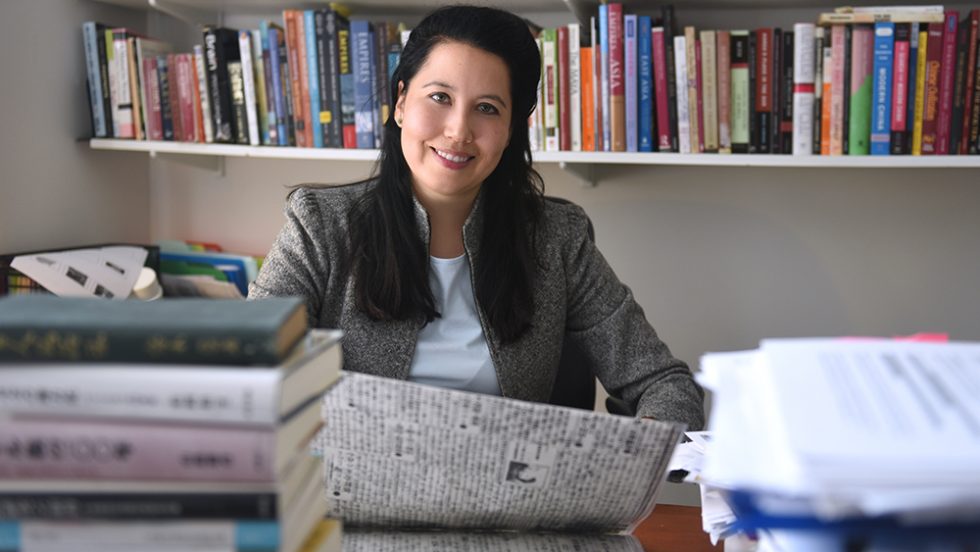
Kirsten Ziomek, PhD, associate professor and director of Asian studies, has been recognized with a fellowship for research on Japan in World War II. Her expertise on forced labor and colonial soldiers brings a new understanding of the Asian-Pacific operations.
People and their stories can get written out of history. Incomplete information can leave us with a partial view of past events that leaves us unable to understand the present as clearly as we should.
That’s why Kirsten Ziomek, PhD, associate professor of East Asian history and director of Asian Studies at Adelphi, is writing a book that will shed light on a forgotten corner of history: the diverse ethnoracial makeup of the Japanese fighting forces in World War II. Historical scholarship tends to tell us Japan fielded a racially homogeneous force of professionally trained Japanese men to fight against the Americans. But the true story is more complex, Dr. Ziomek said. A vast and diverse group of people fought alongside the Japanese.
She’s found compelling stories.
“Civilian women on certain islands of Okinawa cut off their hair, put on men’s uniforms, took guns and fought and died alongside Japanese soldiers,” Dr. Ziomek said. “Indigenous Taiwanese fought alongside Koreans and Japanese soldiers in New Guinea, the Philippines and other parts of the Pacific.”
Dr. Ziomek is able to write the book thanks to a $60,000 fellowship from the National Endowment for the Humanities and the Japan-U.S. Friendship Commission. Its working title is The Disorder of Killing: Colonial Soldiers, Forced Laborers, and the Local Peoples on the Japanese Empire’s Edge. She’ll take a year off from teaching to write the book.
Providing a new look at the makeup of the Japanese military
These stories are important because they correct misconceptions that Japan’s military was a homogeneous monolith that rolled over the locals every place they went, Dr. Ziomek said. “My research reveals that the Japanese needed different ethnic groups to fight or provide labor in these areas. They were reliant on these people.”
Her research aims to show that various ethnoracial groups in the Japanese empire and locals in the lands where battles were fought weren’t passive bystanders. Nor were they merely playing auxiliary roles as they have often been depicted in Japanese military histories. “It’s usually like ‘Oh they built roads or they carried supplies or they carried the wounded,'” Dr. Ziomek explained. “But many also fought and died on the front lines. It is often these people who get written out of military history as inconsequential to actual on-the-ground fighting. What my research aims to do is show how it was not just white Americans fighting homogeneous Japanese.”
Dr. Ziomek sees parallels between the forgotten stories of non-Japanese combatants in the Japanese army and African-American soldiers’ experiences in the United States armed forces during World War II. “These people are used for the war and when the war ends, none of the promises made to them are made good,” she said. “There’s this longer fight for recognition and compensation.” She is including narratives of African-American soldiers as well as of Americans of Japanese ancestry in her research along with those of white soldiers to provide a fuller telling of the varied experiences in the war. “I want to get a sense of how different groups talk about their war experiences,” Dr. Ziomek said.
One of the more surprising stories Dr. Ziomek has uncovered is that a force of Japanese and Indigenous Taiwanese soldiers massacred about 300 American and Filipino troops before the Battle of Bataan in the Philippines in 1942. “It raises questions of how we think about stories of war,” she said. “We usually believe the Japanese used and oppressed colonial and Indigenous people. Now we’re seeing oppressed people inflicting violence and committing horrific acts. How does that change our understanding of war and our understanding of colonial history?”
Telling a vast story through individual stories
Dr. Ziomek has dug into Japanese archives, the National Archives and the Library of Congress, just to name a few. She watched interviews with World War II veterans on old VHS tapes and read transcripts of interviews. She’s looked at photos and films shot by the U.S. military. She’s read Japanese language sources and used databases in Taiwan and Korea. Her goal is to find the testimonies of people who were there and give a broader view of history by reconstructing their individual stories.
“I’m trying to get as realistic as possible as to what a fighting scene would look like on a specific island,” she explained. “I’m trying to put those people on the battlefield in real time, interacting with people from many different groups. I want to figure out what sort of bonds they formed and how they worked together.”
Her goal isn’t to displace official U.S. military history but to add more perspectives to it. “I want to ask why military histories are being narrated from one perspective and not others,” she said. “How does our view of the war and fighting change when we include these other perspectives? The information we find out can tell us about the past as well as present politics.”
This will be Dr. Ziomek’s second book about Japanese history and culture. Her first, Lost Histories: Recovering the Lives of Japan’s Colonial Peoples (Harvard University Asia Center, 2019) told the stories of people from four ethnic groups—the Ainu, the Indigenous Taiwanese, Micronesians and Okinawans—during the 20th-century colonial period in Japan.